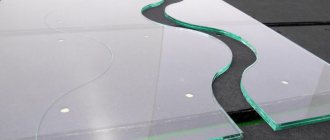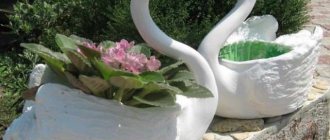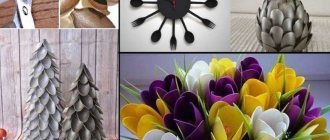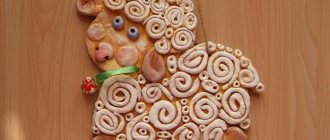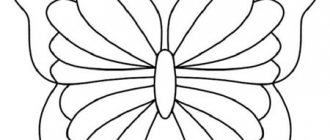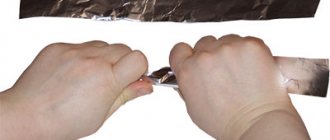If there is unnecessary glass in the house (whole or broken) that clutters up the space, do not rush to throw it away.
You can make a beautiful product out of it, or decorate existing items.
This is a good way to put this material to use , since handmade crafts and gifts are valued much more by people.
In this article we will tell you what can be done with whole or broken glass, how to make a herbarium in it or bake a flower, how to turn its surface into a matte or mirrored one, and other subtleties of craftsmanship.
What do you need to know before you start?
Glass is a universal material used to create various interior items.
Not only dishes and furniture are made from it, but also paintings and panels.
You can give a second life to even a broken object by using shards and fragments.
There are different types of glass, differing depending on the application :
- construction;
- porous;
- liquid;
- artistic, finishing, etc.
Such a variety of materials allows a skilled person to create unique kaleidoscopes and make products of bizarre shapes and colors.
Even a beginner can create many crafts ; the main thing is to have the necessary tools, patience and desire.
First you need to determine what exactly you want to make from glass. Here a lot depends on the author’s imagination and the resources at his disposal.
All products can be divided into categories:
- household;
- aesthetic.
Here are just a few examples:
- candlestick decoration;
- ornaments on glass, flower compositions;
- small souvenirs made of broken glass;
- thematic installations;
- decoration of household items - dishes, chandeliers, mirrors.
Let's figure out in order what items can be made from old unnecessary glass.
Story
Making glass beads is one of the most ancient forms of art, originating about thirty thousand years ago. In the Ancient states of Egypt, Mesopotamia, Phenicia and Syria, amulets, amulets, decor for dishes and jewelry made of transparent glass were considered luxury items. The history of modern glassblowing is connected with the island of Murano near Venice, which for many centuries was famous for its many factories and inimitable craftsmen. Refined jewelry made from fragile colored material is called “Murano” or “Venetian” glass.
Shelf
Glass shelves are popular because they can easily fit into any interior . In addition, they can withstand significant loads, although they seem fragile.
Glass furniture looks good in small rooms - because of its transparency, it seems less noticeable, so it does not visually take up space in the room.
The location should be accessible to adults, but inaccessible to children (so that the child cannot hang on it).
To make a shelf you will need:
- glass cutter (it is more convenient to use an oil cutter);
- belt-type sander with abrasive sandpaper (grit value should be 120 units);
- respirator, gloves and other protective equipment;
- rulers (you will need to periodically check whether the layers are even).
It is created in the following order:
- You need to prepare a template , knowing in advance the exact dimensions of the shelf, as well as measuring the angles between the walls where it will be installed. The task is to take the most accurate measurements so that in the future the glass structure fits perfectly against the wall.
- Cut and process glass of suitable size . This can be done using a glass cutter. You need to make one cut and then break the glass along a pre-designated line. In case of an error, it is better not to make repeated cuts to the glass, otherwise scratches or cracks may form. To begin with, you can practice and cut several pieces of unnecessary glass.
- Glass sections also need to be processed. Otherwise, when using the shelf and using it carelessly, there is a risk of injury. When performing grinding, periodically wet its surface (this will remove dust, which can get into the lungs when cutting, and also make the surface of the glass transparent).
- All that remains is to fix the glass structure. The fastening itself must be reliable and aesthetically pleasing. Holders or an aluminum profile are suitable for this.
Precautionary measures
When working with resin, safety precautions must be strictly observed. You need to immediately buy personal protective equipment:
- respirator,
- gloves,
- apron,
- protective glasses.
Do not work in an unventilated area. If there is not enough ventilation, you will have to breathe fumes, which is harmful to the body. Vapors may cause an allergic reaction and irritate the respiratory tract. The strong chemical smell is unpleasant, although some expensive brands of epoxy do not smell as bad. After curing, the epoxy resin is completely safe; various rings and brooches can be given even to children.
If resin or hardener gets on your skin, immediately wash the area with soap and then plenty of warm water. Epoxy should not be used on products that come into contact with food. When polishing, you should also wear a respirator - this way the smallest particles of the substance will not enter the respiratory system.
Aquarium
To make it yourself, you will need:
- Premium grade silicate glass .
- Glue containing silicone. Look carefully at the information on the packaging: it should indicate that it is suitable for aquariums (it does not contain antibacterial substances that harm fish and plants).
- About 8 pieces of small corners , suitable for pre-designed sizes.
When gluing parts, you need to remember certain requirements:
- the seams must be thick, at least 2-3 mm;
- The outer edges must be sanded, and those under the glue must not be touched.
The build process itself looks like this:
- We take one block and make a hole in it with a thread for a bolt of a suitable size. In the other we make several holes for the self-tapping screws on which the bars will be attached.
- Total will be used 4 bars of the same length, on both sides of which corners are attached. The length of the bar determines the internal width of the aquarium.
- Prepare 8 plywood and rubber spacers of suitable size.
- The glass that will be located on the sides must be clamped with a special device . The bars ensure the same length and parallel arrangement of the glass relative to each other. But keep in mind that you will have to work hard before you get right angles between the edges of the glass. You will need to take a square and measure the diagonals.
- The resulting structure must be laid on its side and glass attached to it. If everything is smooth, then the side windows are positioned perfectly.
- We apply sealant and carefully lay the front glass, pressing down a little so that the substance fills the seam completely.
- After a couple of hours, you can turn the structure over again and glue the rear window in the same way.
- Wait two hours for the material to dry.
- Next, you need to remove the bars from the bottom of the glass, then turn the structure upside down and glue the very base (bottom) of the aquarium here.
- Again, leave the product for two hours, turn it over and glue strips of glass along the top edge. In this design they play the role of stiffening ribs.
- We leave the product for exactly one day . This time should be enough for everything to dry. Now the aquarium is ready.
Do not rush to immediately “transport” fish and other marine life here. Conduct a 3-5 hour hydrotest - fill it with water and check whether the structure is leaking liquid, whether the seams are leaking, etc.
Now you have an idea of how to make an aquarium yourself at home.
Making a glass pendant using fusing technique
A couple of months have passed since I became the proud owner of a small microwave fusing oven. Happiness cost me a pair of damaged thermal gloves, a bunch of damaged glass (I plan to recycle). My family has practically lost the ability to use the microwave. But the result is worth the listed sacrifices - charming cabochons, beads, pendants and even earrings. The stove was white when purchased, but has changed somewhat now. It's OK. The main thing is the result. We will need: a microwave, an oven for fusing in a microwave, a glass cutter, a hammer (I have a hammer combined with a glass cutter), preferably liquid for cutting glass, fiber paper, heat-resistant napkins, pieces of glass of different colors, millefiori. The glass pieces must have the same COE (coefficient of expansion), otherwise the glass may crack.
This is what the stove looks like. It consists of an upper (cylindrical) and lower (round) part. There is a hole on the top through which we monitor the stages of glass sintering.
This is what the bottom part of the stove looks like - a disk on which we lay out a glass “sandwich” for subsequent baking.
We take a glass cutter.
It is advisable to lubricate the glass with glass cutting fluid. This way the pieces will turn out smoother. We draw a strip along the glass with a glass cutter.
We break off a piece of glass with a hammer. The glass should lie on the edge of the table. Carefully hit the part that is on the table. I use this method, but you can break off the glass with wire cutters, special tongs or pliers. I apologize for the quality of the photos - I had to shoot with one hand.
We do the same with glass of a different color. We cut it.
We beat back.
We take a piece of fiber paper (aka thermal paper), cut out a thin strip from a heat-resistant napkin (included in the set with the stove, they are much thicker than fiber paper); millefiori (special round pieces of glass, which are used in various techniques, were also included with the set). I save heat-resistant wipes, so I use fiber paper, which I was able to buy in a large sheet at a stained glass store, but you can use heat-resistant wipes instead of paper.
We place a piece of fiber paper on the bottom of the stove, and then put the bottom of the stove in the microwave. The plate in the microwave should be upside down (so it doesn't spin).
Next, place a piece of glass on the thermal paper, which is slightly smaller (about a millimeter along each edge). In my case it is white glass.
Place a strip cut from a heat-resistant napkin on the glass evenly in the middle. It is slightly thicker than the fiber paper on which the product is baked, otherwise the pin hole will be too narrow.
Carefully place the next piece of glass on top of the strip. It should be slightly larger than the bottom one so that the hole for the pin is exactly on the sides or back of the pendant. The ends of the strip should peek out from under the glass.
Next, place millefiori on top of the resulting “sandwich.” This is the most difficult stage, it requires certain skills. The fact is that if the distribution is uneven, the previous layer may lose balance. This will cause the glass to “float away”. You will end up with either a crooked bead or two different glass blots. I had two pieces of millefiori roll off during the first stage of baking. I carefully removed them. Cover the stove with the top. Close and turn on the microwave for 1-2 minutes.
Open the microwave and carefully open the oven. Let's see. At this stage, I discovered that two millefiori had flown off. I removed them. Attention! Do not attempt anything with unprotected hands. Use thermal gloves. I cleaned Millefiori wearing gloves and using a thin knife.
As a rule, I turn on the stove for another 3-4 minutes, then look again. At this stage, the glass is already beginning to melt, so there is practically nothing that can be corrected, you can only make sure whether it is worth continuing further.
Turn on the microwave for another 3-5 minutes. An orange light appeared in the hole located on the top of the stove. This means that the stove has reached its highest temperature (1000 degrees). The time and order of sintering depends on many factors. First of all, it depends on the power of the microwave and the voltage in the electrical network. In our area there is poor electricity supply in the evenings. That's why I bake for a long time. On the forums they write that 2.5 minutes is enough. Next, turn off the microwave. Leave the oven in the microwave for about 5-10 minutes. Next (wearing thermal gloves) we transfer the stove to a ceramic surface. Open the oven after at least 30 minutes. I usually wait at least an hour.
Open the stove. Remove the cooled bead. This is what happened.
We clean and wash what is left of the strip (as soon as I touched it, it turned into dust or into a very fine powder) from the resulting pin hole. I do this using a wire or pin, warm water and dishwashing liquid. Next, we try on how well the jewelry pin fits.
Continue to fantasize! I don't give detailed instructions in this part. It all depends on your imagination, taste and wishes. I took a silver pin and put a red Swarovski bead on it. The pin was inserted into the newly cleaned pin hole. I put another bead on the pin.
I bent the tip of the pin into a ring (you will need pliers), having first threaded it through the bail ring, since I used a bail with a closed ring. I pushed the tip of the pin back into the bead. Secured with jewelry glue. This is what happened.
Greenhouse
Glass is often used in the construction of wooden or metal greenhouses. This is a classic version of greenhouse structures, which allows you to maintain the necessary microclimate inside .
If you have a lot of window glass leftovers, you can successfully use them to create a greenhouse.
Such a structure has walls and a roof made of glass, which provides a number of advantages:
- The greenhouse can be used all year round. The material retains its transparency, structure, appearance and thermal insulation properties.
- By connecting heating to it, you can grow plants in winter . In summer, transparent glass allows light to pass through, allowing plants to grow.
- Glass withstands abrasive influences and is easy to clean.
- The walls of the structure can be easily replaced in case of damage . Replacement is inexpensive, and used glass is suitable for this.
- Glass does not emit harmful substances or odors even when exposed to heat. This is an environmentally friendly material that is also easy to care for. Glass is resistant to chemicals used for cleaning.
- The reinforced or tempered type (thermal glass) can withstand large hail and other adverse weather conditions.
In addition to all these properties and an attractive appearance that lasts for years, this design has disadvantages :
- It is necessary to select a reliable frame and prepare a strong foundation (a strip foundation can withstand such loads), since glass is characterized by increased weight . You wouldn’t say so at first glance, but the material weighs a lot: for example, glass 4 mm thick in a square shape weighs about 10 kg, and the weight of a 6 mm layer is 1.5 times more.
- Building a glass greenhouse will not be cheap.
- The glass resists shock and mechanical impacts poorly.
- Glass has high thermal conductivity, so it heats up and cools down quickly . This is especially harmful to plants during daily temperature changes. Therefore, you need to take care of the system for maintaining the desired temperature inside the room.
- A glass room can only be built in the form of a house.
It all starts with preparation:
- Creating a drawing of the future greenhouse, determining its dimensions.
- Choosing a suitable location. It is necessary to take into account the level of lighting, orient the room so that the heat is distributed evenly.
- Taking into account the wind direction in a given area. It is best to protect the structure on the leeward side with some object (shrub or other small obstacle).
- Determination of soil and relief features. You need to choose a dry and level place.
- Calculating the distance of the greenhouse to the nearest source of electricity and water supply. The closer you get, the easier it will be to build a system for heating and watering plants.
The following shows where not to place a greenhouse. If you make the wrong choice, the greenhouse may collapse or the plants being grown will grow more slowly.
A reasonable solution would be to create a wall-mounted greenhouse. This will save site area , reduce the distance to water and electricity and spend less money on construction.
Below is a typical drawing. If desired, it can be changed according to the desired dimensions.
Building materials are selected based on the drawing . The foundation must be at least 0.5 meters in height and have a strong frame - metal or wood (bars or profiles measuring 5 by 5 cm, the distance between the posts is up to 0.8 m, based on the size of the glass and the frame itself).
You can use different types of glass. The main thing is that they match the dimensions of the frame . Eg:
- single (2.5 mm thick) suitable for side walls installed in a small wooden frame;
- double (up to 3.5 mm) cannot be used as a top window;
- showcase (6 mm) will become a strong wall, but will need reliable fastening and supports;
- multi-layer will work in almost any part.
Select glass based on the purpose of the structure .
If the greenhouse contains tropical plants, it is better to use multi-layer glazing, which will reduce the cost of internal heating.
Regular glass is also suitable for greens and vegetables.
Double-glazed windows provide the best growth. There are several types:
- single-chamber;
- two-chamber;
- heat-saving;
- energy saving.
Double-glazed windows from old plastic windows are perfect.
You will need to prepare the following building materials :
- support corners;
- wooden beams or metal bases for each side of the frame;
- beams;
- polyurethane foam and hardware;
- glass or double glazing;
- sealant (for fixing and insulating glazing);
- door parts (handle, lock, hinges);
- corners on which wooden parts will be attached.
Cords, pegs, containers, buckets and shovels are needed for marking and preparing the foundation . A hacksaw, chisels, glass cutter, electric planer and construction level will be needed when assembling the greenhouse.
Now that everything is ready, we’ll tell you in detail how to make a greenhouse.
Assembly is carried out in the following order:
- At the selected location, you need to level the soil and remove vegetation. Make markings for the trenches by installing pegs and cords.
- We dig trenches according to the intended markings (depth 0.4 m, width 0.2 m). Let's plan the bottom of the pit, fill it with a 10-centimeter layer of a mixture of crushed stone and sand.
- We assemble the formwork and check the height of the edges. We lay welded mesh or steel reinforcement and attach anchors to the frame.
- We prepare concrete (a mixture of cement and sand 1:3 with the addition of crushed stone and water). Pour in the resulting solution and give it time to harden.
We lay two layers of roofing material directly on the surface of the foundation. They will protect the wooden frame from moisture. We treat wooden blanks with an antiseptic.
Screw the support bars of the frame to the anchors, then make holes in the bars on which the glass will be attached.
We fasten the racks and beams.
Make sure the structure is upright. Install the braces and secure all elements with metal corners .
Next, assemble the roof frame using rafters and beams. Then you can hang the doors. After cutting the glass, install the elements into the grooves of the beams. To do this, use sealant, putty or liquid nails.
Connect all the remaining elements together. Check everything first for cracks and gaps, then make sure the structure is strong . When it is clear that the greenhouse retains heat, bring all the plants into it.
Colored mosaic
A special mosaic - smalt - is suitable for decorating surfaces. But if it is not available, you can use colored broken glass. By the way, smalt is also made from broken glass; you can read about it in detail here.
To do this kind of work, you need to prepare:
- drawing, glass base for mosaic (or plexiglass);
- glass cutter, wire cutters and a special breaker for working with glass;
- colored glass from which the mosaic will be made;
- medical syringe, which is useful for applying the material;
- transparent silicone;
- tile grout (black).
Consider making a mosaic in the shape of a butterfly.
So, the finished drawing needs to be transferred from paper to a glass base. Using tools, we cut out wings from colored glass. Then we cut it out with a glass cutter.
After they are separated from the base, you need to lay them out on the prepared drawing .
The pieces of glass need to be coated with silicone, then glued to the glass base. For this you will need a medical syringe.
When you glue the fragments together, leave gaps between them. They will need to be filled with grout later.
The seams need to be rubbed only after the silicone has grown.
Be sure to wear rubber gloves. the grout itself according to the instructions located on the package with the substance. The result will be a mixture as thick as sour cream.
We apply it to the mosaic.
As you can see, it covered the entire surface of the product, and the seams are securely sealed. All that remains is to remove the excess mixture from the glass. This can be done with a wet sponge .
The procedure for creating any other mosaic is similar; the specifics of the work will vary slightly depending on the design.
Here is an example of another product made using the same technology:
As you can see, mosaic is a universal technique with which you can decorate completely different interior items using broken glass.
The main thing is to draw the contours in advance so that the resulting drawing looks organic.
Second life of glass bottles
Decor from unnecessary containers
Glass containers sometimes have an original, bizarre shape. Throwing away such a bottle will not raise your hand. These bottles can be used to create holiday decorations. If you put a string of New Year's garland inside, you will get an elegant lamp.
Inside the container, you can plant the plant on a moss substrate. A composition of many bottles of different shapes creates in the apartment an imitation of an exotic garden in miniature. The surface can be decorated with twine, pebbles, shells, and the bottle will become an original flower vase.
Use of glass residues in everyday life
The fight of bottles and cans is often used to decorate the basement of buildings. To do this, broken glass is placed in a concrete mixer and crushed into small pieces. Then a solution is obtained, which is mixed with the fine glass fraction. This mixture is used in construction.
Glass that has stood in a barn or balcony for a long time can be used to create an aquarium, build a greenhouse or greenhouse. Glass does not deform, transmits light, and is not exposed to aggressive substances.
The list of glass products and crafts can be expanded endlessly. The ability to create a masterpiece out of unwanted trash called talent. Skillful hands, sewn with imagination, can create beautiful things out of nothing that will delight and delight.
Herbarium and flower in glass
This is a very unusual, rare and beautiful fake. This technique allows you to “immortalize” any flower (or other object) in glass, making it into a decoration (for example, a pendant).
First you need to dry the flower. Next, you need to bake the plant in glass.
Naturally, in order for the sheets to be visible, you need to use only transparent glass (intended for fusing or regular glass).
The only tools you may need are a special oven, a glass cutter and a machine for grinding the edges of glass.
You need to cut and sharpen two circles of equal diameter , the dimensions of which will fit the flower. Plus, you need to leave a little space if you want to make a pendant (a hole will be made in a small area for the cord).
By the way, this is a difficult operation to predict the end result. It is difficult to control the process : the grass may burn completely, or a clear silhouette will remain.
To minimize possible damage, it is better to paint the flower in advance: even if the leaves fade, the paint will retain the original shape of the flower and remain inside the glass.
You can approach the matter artistically by coloring the flower with transitions of shades.
You need to use only fusing paints - they do not fade at high temperatures. After applying it, you need to let it dry.
We put the painted plant between the pieces of glass and put it in the oven.
You need to choose the right baking mode . It is selected depending on the glass used. The approximate range is 740-800 degrees.
Please note that air bubbles may form . If after baking there are few of them and their sizes are small, they can further decorate the product.
If the plant burns out only partially, it may turn out a little lacy and fibrous.
What can you create?
In addition to the usual elements for beads with or without artistic painting, professional lampworkers sculpt mini-figurines of anything: flowers, berries and fruits, insects, sea creatures. With basic skills, you can smelt micro-masterpieces: a cosmic sphere, a frozen sea, microscopic bouquets and myceliums hidden in balls. There is no limit to perfection and imagination in such art. The resulting parts are used for further production of beads, bracelets, earrings, souvenirs, and table decorations.
Photo frame
A more difficult operation will be decorating frames, panels and paintings.
Before making a frame with glass, you will need to prepare:
- a sheet of fiberboard of a suitable size (dimensions are selected based on the intended design);
- broken glass (transparent and colored);
- acrylic paints, gouache or ink;
- glue.
A thick layer of acrylic paint is applied to the fiberboard sheet. If desired, you can cover it with one or more shades . This is necessary to prepare the background. When everything is dry, the sheet needs to be inserted into the frame of the future product.
Then, on the future panel or painting, you need to apply the contours of the planned design using a stencil or by hand.
This is why ink or gouache was needed - to circle the outlined lines twice and glue the fragments along them.
Having pasted them in the background area, you need to let the product dry.
Industrial use
- Glass from collection points arrives at factories and is used to produce new glass containers. Broken, finely ground glass is also used as additives in the production of concrete. It is believed that the presence of glass in concrete prevents rodents from entering the room through the foundation. This type of concrete can be used to fill the foundation of any building, the floor in utility rooms, the walls of the cellar and rodents will not be able to enter these rooms.
- Broken glass is used to make abrasive tools such as sandpapers and wheels.
- Another method of using broken glass is to make glass tiles for bathrooms. This idea is useful for organizing a small business.
- Broken glass is the same sand from which it is made, and it can be used in the same place where sand is used.
Mirror
The easiest way is to decorate mirrors using shards (colored or transparent). This can be done with vases, candlesticks, and trays.
Since the essence of the decoration is gluing pieces of glass, be sure to wear rubber gloves before starting work; they will protect your hands from cuts and allergies to substances contained in the glue.
On the surface of the object you must first apply pattern markings along which the fragments will be laid out. Only ceramic glue is suitable, layers of which must be applied using a special tool - scrapers.
If transparent pieces of glass were used, they can be painted with acrylic paint designed for working on glass.
After the layer with the fragments has dried a little, the holes between them can be sealed with tile putty or mosaic cement. You need to act carefully, but there will still be excess. You can remove them using a damp cloth.
This is what mirror frames made in this style look like.
You can decorate in a similar way:
- frames for photographs, mirrors, paintings;
- flower pots;
- caskets;
- drawers;
- countertops and other items.
Main:
- accurately calculate the number of pieces of glass (prepare paint to finish painting the transparent pieces);
- apply clear markings and indicate where and what layer will need to be laid.
Other items and decorations
The list of crafts is not limited to this. Here's how else you can decorate your interior.
Picture made from multi-colored glass cullet
All work can be done at home, having prepared in advance:
- plywood;
- finished drawing;
- a bunch of colorful pieces of broken glass.
Plywood is needed as a base-frame on which the drawing with glued pieces of glass will be held. The picture itself can be drawn in advance, or you can take a suitable template.
The pieces should be glued so that they fit tightly to each other. It is better to use a more stable glue . Try to ensure that they follow the lines, observing the pre-planned color scheme of the drawing.
Do not touch the glass under any circumstances until the glue has dried, otherwise there is a risk of moving the pieces from their original location.
In addition to pieces of glass, you can use other elements for decoration:
- beads;
- seashells;
- glitter;
- buttons, etc.
Drawing using fusing technique
You can make a multi-colored picture using either mosaic or fusing techniques. It involves baking pieces of glass, pre-folded into a specific pattern. The entire operation is carried out in a muffle furnace at high temperature (at least 800 °C).
This technique first appeared in the 90s. in Germany, and it was based on another, more ancient method of glass processing - the “hot enamel” technique.
The main task is to correctly position the glass elements in advance so that as a result of heat treatment they are combined into one whole . Consequently, the material becomes homogeneous; there are no metal compounds in such a product.
The image completely depends on the artist: you can make it more voluminous, convex, leave some areas flat, increase the thickness and relief of the stained glass.
All scattered parts are laid out on a glass base - the most even and flat surface possible. Thanks to this, the illusion of perspective, volume, and depth of the product is created.
The use of colored pieces allows you to expand the color range. This is precisely why you need a glass base, since working on a metal plate you cannot achieve such an effect.
This product is also quite durable. It practically does not age, the color remains unchanged.
The only drawback in the heat treatment itself is that this technique will not allow you to obtain clear contours of the image . Colored pieces inevitably float on top of each other, resulting in an effect similar to watercolors.
Using liquid glass
Advanced craftsmen can create crafts using liquid glass.
You can buy such material at a construction or hardware store . Or use other types of liquid glass, for example, stationery silicate glue, which is often used to imitate sea spaces.
But such a substitute will be less durable and hard than liquid glass.
Almost any item can be decorated with this material.
After applying a layer of liquid glass, apply decorations on it - pebbles, shells, beads, sparkles, etc.
If you want to make decorative elements more voluminous, apply two layers of liquid glass.
Liquid glass is quite easy to work . You can use it to decorate the surfaces of various objects or make your own decorations:
- hairpins;
- earrings;
- brooches;
- figurines;
- vases, etc.
You can decorate your interior with liquid glass in a simple way - apply small objects to a layer of glass according to a pre-designed pattern, then let the product cool.
Decor elements
What can you do if you only have small broken glass on hand? It can be turned into powder and used as decoration.
To crush it into powder, you need to follow safety precautions :
- use gloves and safety glasses;
- Find a container that is deep enough and strong enough.
The resulting broken glass powder is applied to the selected item in areas where glue was previously applied. As soon as the glue dries, you can cover it with another layer . By analogy, powder can be used to paint pictures and decorate interior items.
In addition to glass, you can additionally decorate objects with the following materials:
- shells (sea or river) and shells;
- beads or beads of a suitable size;
- walnut shells and other available materials.
The task is to choose the right combination of all decorative materials, then the product will look beautiful and organic.
Features of fusing. How it differs from standard stained glass technology
Overall, these two techniques are quite similar to each other. Their result is a bright composition made up of colored glass. These technologies are related. Fusing can even be called a type of stained glass technique. The difference is that in traditional stained glass the color boundaries indicated by metal elements are clearly visible. Smooth, gradual transitions of shades are impossible for this technique. It’s a matter of fusing, in which soft, barely noticeable color boundaries make the image more pleasing to the eye and natural in appearance.
Making black, white and colored paint for glass at home
How can you make glass colored, white, or apply a design on it at home?
Glass surfaces must be treated with special paints that have good adhesion to smooth surfaces . Conventional paints and varnishes are not capable of this, so the coating wears off quickly.
The composition of the paint should not be too liquid, and it should be applied in thin and translucent layers.
Acrylic paints are best suited for liquid glass. They have good adhesion, and on surfaces they look like a matte film. Even when mixed, they retain color purity and are resistant to ultraviolet rays.
You can paint the surface with polyurethane mixtures. This is an elastic substance that instantly hardens on glass. The layers are perfectly transparent.
You can make the compositions yourself.
Here are a couple of recipes :
- White paint is prepared by mixing four parts silicate glue and one part kaolin (it must be thoroughly ground).
- Black shades are created by mixing one part charcoal with three parts silicate glue and one part printing black. The resulting mixture must be filtered.
Various colored dyes can be made using special fabric dyes.
The procedure is as follows: dissolve 5 g of gelatin in 200 ml of water, then dilute the necessary dyes in a separate bowl. The required shade is obtained by gradually mixing the contents of two prepared solutions.
Prepare the following tools in advance to paint glass with paint:
- spray;
- end brush with bristles;
- a paint roller or a foam swab.
You need to pre-treat the glass:
- Wipe the glass with soapy water, then rinse first with warm and then with cold water.
- Apply acetone to degrease the glass. Traces of solvent can be removed with a simple dry cloth.
- Those areas that do not need to be painted should be protected. Apply one or two layers of masking tape to these areas.
Instructions for painting glass at home:
- Prepare the mixture and pour it into a small container (this will make it easier to apply paint to the surface).
- Paint glass using a brush, spray gun, foam pad or roller. Make sure that the layers are distributed evenly over the entire surface.
- When the paint is dry, remove the pieces of masking tape. If some areas are poorly colored, apply an additional layer.
How to make it opaque?
You can achieve a matte glass texture:
- chemical and mechanistic methods;
- using a sandblaster.
Follow the instructions below and you will learn how to make glass opaque.
It is easier and safer to use a mechanical method based on the use of abrasive paste or sand.
You need to take polished glass with a thickness of 4 to 6 mm, place it on a flat surface, placing a thick cloth under it.
Thin spatulas need to be nailed to the sides of the glass so that it does not slide on the table.
Prepare sand (river sand or corundum sand is best: it scratches glass more smoothly), then sift it through a sieve until smooth .
Then apply sand to a board measuring 20 by 30 cm and moisten it with water. Place glass on top of the board, and any weight on top of the glass so that it presses it tightly to the surface.
Move the board parallel to the side edges of the glass. Do not make circular movements under any circumstances.
Moisten the sand as it dries.
Periodically check whether the matting process is successful by removing sand from the surface and holding the glass up to light. Continue the procedure until you get the expected result.
Create a mirror surface
How to make a mirror? First you need to polish our glass by wetting its surface with water.
to prepare the following items in advance :
- glass;
- containers in which the solution will be prepared and mixed with silver;
- latex gloves;
- silver (nitrate) and tin (bichloride);
- distilled water, caustic potassium or soda;
- honey, ammonia and formaldehyde;
- alcohol, cotton wool;
- clear varnish;
- glass rod and nitric acid;
- a spray bottle that will be used to apply the mixture to the glass, plus a brush with soft bristles;
- frame or wooden sheet with clips;
- dye.
We put on rubber gloves and carry out all work exclusively in them.
Next, when you manipulate the glass, hold it carefully by the edges, otherwise you risk staining the smooth surface . This is important because the material will need to be frequently dragged from place to place, washed and various substances applied to it.
The procedure is as follows:
- We wash the glass with distilled water and crushed chalk. All sides must be clean, incl. ends.
- We treat the surface with a degreasing alkali solution (sodium or potassium, containing about 10%).
- Rinse the glass again with distilled water.
- Wipe clean glass with a cotton swab dipped in a 1% solution of stannous chloride. Then immediately place the mirror in a container filled with distilled water. Let it get wet.
- While the glass is poured, clean and degrease (with the same alkaline solution) the container in which you plan to silver the glass. Please note that the surface temperature of the future mirror in water should be 10 degrees higher than that of the solution induced for silvering.
You will need to prepare two solutions containing the contents with which the glass will be coated. Use only distilled water:
- The first solution consists of silver nitrate (1.6 g) and water (30 ml). After mixing them, watch what kind of sediment you get. Drip 25% ammonia into it until it disappears, then add another half cup of water.
- Pour a 40% formaldehyde solution (5g) into the second container with divisions.
Mix both liquids.
Then proceed like this:
- Place the glass horizontally on the surface prepared for silvering.
- Now start covering the glass: pour the resulting solution into the middle, roll it out in an even layer using a glass rod. Or lower the glass into the chemical mixture so that the silver does not fall on the opposite side.
- The solution needs to harden. To “mirror” it needs 3-10 minutes, depending on the initial temperature of the mixture.
- When everything is dry, you need to place the mirror vertically. While the silver layer is not fixed, it may be damaged, so lean the product against the support with the untreated side.
- The mirror needs to dry for 2 hours at temperatures up to 100 degrees.
- Inspect the received product. Silver stains can be wiped off with cotton wool and a solution of nitric acid.
- Rinse the mirror first in water and then in alcohol.
- The silver layer should have cooled by this time. Spray it with clear varnish from a spray bottle.
- When the varnish is dry, paint the darkened surface. Then paint the silvered part with red lead, diluting it in turpentine. The glass part must be wiped with a solution of nitric acid.
- Let everything dry and look at the result. If everything suits you, all that remains is to place the mirror in a frame with clips.
Working with jewelry resin
Costume jewelry is the most popular area for using epoxy among needlewomen. In order to make jewelry, you need to purchase the appropriate molds. This is the name for pouring molds that are made from silicone or other materials. They are easy to use and the finished product can be easily removed from them.
When working with resin, you must strictly observe the temperature regime. The polymerization reaction proceeds with the release of heat, and the epoxy heats up to +60 degrees. When overheated, it deteriorates irrevocably.
Preparation of the workplace
To work with jewelry resin, you will need a flat place - a small table, a tray. The base coating should be glossy and not stick to the resin. The use of plastic bags is inconvenient; drops of resin stick tightly to them. It is best to cover the tray with paper tape with a shiny surface. You can also put ceramic tiles or a sheet of cardboard on the table.
Before work, it is important to prepare all the necessary equipment, fittings, and decor. The basic materials you will need are resin and hardener (usually included). Also useful:
- two syringes (no needles needed),
- dishes for mixing resin (you can take a disposable cup),
- wooden stick for mixing the mass,
- mini drill,
- attachments for mini-drills for grinding, polishing, drill attachment, turning head,
- individual protection means,
- sieve,
- vegetable oil or Vaseline,
- tweezers.
Accessories are selected depending on the type of jewelry being made. These can be bases, connecting rings, earrings, connectors, frames. You cannot skimp on fittings, otherwise the fasteners and fastenings will quickly deteriorate. The decor for the products is chosen independently. These could be the following items:
- cones,
- leaves,
- flowers,
- shells,
- dried flower,
- rhinestones,
- beads,
- glitters,
- sequins.
Natural material - plants, flowers - is pre-dried between the pages of the book. It must be prepared in advance, because the drying process can take up to a month. The buds are threaded through the stems using a sewing needle. The resulting “garland” is hung in a dark closet, it dries for 3-4 weeks.
Resin preparation
Before working, it is important to read the instructions for the jewelry resin. It will indicate what temperature in the room should be maintained, what are the proportions of resin and hardener. Typically, the manufacturer advises working at +25...+30 degrees and low humidity - up to 55%.
Since small portions of resin are used to make jewelry, there will be no strong heating during polymerization. Therefore, it is recommended to warm up resins of many brands a little - this is done by placing the tube in hot water (60 degrees). After 5-10 minutes, remove the resin from the water and begin mixing with the hardener.
Operating procedure:
- draw epoxy and hardener using different syringes without needles,
- pour the required amount of resin into a disposable cup,
- add the hardener in small portions in the specified ratio, immediately mixing the mixture thoroughly,
- Stir the product for 3 minutes, but not too intensely - this will cause air bubbles to appear.
Bubbles are the main difficulty that beginners face. To maintain the transparency of the glaze, let the mixed resin sit for 10 minutes. The bubbles will come to the surface and can be pierced with a needle. The finished mass should have the consistency of thick honey.
If required, fillers are added to the product at this stage. Everything is done quickly, before the resin enters the polymerization stage. Wood shavings, sawdust, crumbs, and cork are usually added. It should be taken into account that they immediately fall down, so they must be distributed carefully.
The total mass of filler should not exceed 50%. The more foreign substances in jewelry epoxy, the more fragile the finished product will be. It is better to add a little plasticizer to it (a couple of drops of castor oil will do).
Fill
To begin the process of pouring resin, you should prepare a fine strainer. This method is not suitable if the mass contains fillers. The mold is first lubricated with Vaseline and parquet mastic. This is required only for homemade molds from scrap materials. Molds made of silicone and plexiglass do not need lubrication; the finished product can be removed from them without difficulty.
Next, the epoxy resin is poured into the mold; its depth should not be more than 30 mm. In the first 60-120 minutes, the composition will remain liquid, but will gradually begin to thicken. If you need to introduce decor, this is done using tweezers. It is important not to pour too thick a layer, otherwise the glaze will not be able to harden completely. If the decor is large, then pour in ½ of the mixture, lay the decoration, and then add the remaining resin. The mold must be covered to prevent dust from settling on the surface. Drying time for the product is 24 hours.
Polishing
The resulting resin products must be properly polished. To do this, use a mini-drill with an emery attachment. The decorations are turned as required, while keeping the edges perpendicular to the drill. Next, the edges can be varnished or the resin can be diluted again and the edges can be smeared with a brush. After polishing, holes are drilled to secure rings and fasteners. The drill diameter should not be more than 0.5 mm.
How to make a hole?
A hole in the glass can be drilled using:
- drills with flexible shaft;
- dental burs.
The structure itself can be machined , but the fragility of the glass must be taken into account. Therefore, it is necessary to calculate the force and impact points, as well as the operating procedure.
The processing should not lead to cracks, breaks and chips on the main surface, otherwise the entire product may break.
Before making a hole, you need to prepare the glass for processing. The working surface must be cleaned and leveled. Watch for defective areas - under mechanical stress they can chip and damage the workpiece.
First, make markings: mark the lines of future holes so that surface flaws are located inside the circle and do not extend beyond its limits. Additionally, you can treat the surface with chemicals , ridding it of oil traces.
Determine where the work will be done. You need to prepare the fixing equipment.
The method of glass fixation itself is determined based on the chosen technology for creating the hole.
damping soft materials are placed under the areas that will be affected .
What if you need to make a small hole?
Miniature holes can be drilled using a drill and drill. A drill is required first:
- heat up;
- immerse in sealing wax and hold until the substance begins to melt;
- moisten the tip in turpentine.
After this you can start working.
The second option is:
- Grind camphor and coarse sandpaper particles.
- Pour the resulting elements into a small container and then dilute them with turpentine. Place this paste on a clean glass surface of the workpiece.
- Prepare a small piece of copper wire. It will need to be clamped in the drill chuck. This type of equipment needs to be guided, so prepare a guide jig (plywood).
- The preparation is completed. You can start drilling.
Large holes in glass are made in a different way. If the required diameter exceeds 10 cm , household equipment will not help.
You can still drill, but you must first make a small through point in the center of the future hole.
Any small-format glass of small diameter (up to 1 cm) can handle this. Extraneous chips will occur, but this is not a big deal: they form in areas that will later be removed.
Having received a small through opening, you need to insert and secure a piece of wire into it.
One end is fastened with a glass cutter. After checking whether the elements are securely fixed and whether the tool moves smoothly in a circle , you can cut a circle.
If you can't drill a hole, you can melt it. You will need to prepare equipment in which liquid tin or lead will be prepared. The glass blank is treated with gasoline, acetone or alcohol.
Having made the markings and formed the area for the future hole, the resulting area is sprinkled with moistened sand.
It should be enough to create a funnel, the bottom of which will be comparable in size to the edges of the hole, then metal is poured into it.
After 1-2 minutes it will cool down, and the sand equipment can be removed along with the mold.
As a result, a hole with smooth edges is formed . The risk is only in the melting process itself: it is impossible to control the diameter that is formed after the interaction of glass and metal.
The last option is to cut the hole using a soldering iron. You need to start by creating risks using a needle file.
Carefully mark the zones in which the melt will be made with a soldering iron in depth.
Then you need to warm up the tip and start cutting. Proceed slowly and carefully.
It is better to melt small sections , periodically cooling the glass (this will reduce the risk of deformation in nearby areas).
The result will be exactly the opposite of the above method:
- the boundaries of the intended diameter of the hole will be maintained;
- the edges will turn out uneven.
How to work with glass?
Before making a glass craft, you need to familiarize yourself with the intricacies of the working process. Thanks to skills and knowledge, it is possible to create delightful and irresistible products.
What tricks will be needed to process the surface and side edges? Experts recommend following a few tips:
- To process large glasses you will need a special glass cutter.
- Thanks to this equipment, it is possible to carefully shape the side edges and cut out the necessary parts;
- To ensure that the edges are not sharp, they are sanded using sandpaper;
- To create a matte base, you will need to use a cleaning powder containing large granules;
- To create through holes, use a drill with a thin drill bit. However, the working surface is lubricated with a small amount of turpentine and rosin.
The drill must be operated at low speed. The mixture should evenly fill the recesses until a hole appears on the surface of the glass;
- To clean the surface you will need to use a vacuum cleaner. Thanks to it, it is possible to remove glass dust;
- Don't forget about safety precautions. Particular attention is paid to the eyes. To do this you will need clear glasses.;
- To paint glass surfaces, use a set of acrylic paints and yellow wax.
- The wax base is first dissolved in turpentine. Next, a drier is added to the liquid base.
- This substance allows you to increase the drying speed. Dry dyes can be added to the wax.


